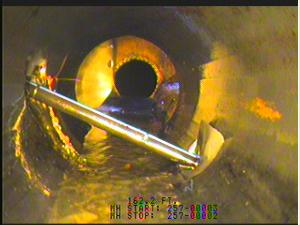
- Home
- History
- News
-
Leading
Practices
-
Legacy Cross
Bores
-
New
Construction
-
System
Integrity
-
Risk Evaluation
-
Drain
Cleaner Safety
-
Videos/Websites
-
Photos-Cross Bores+
-
State Locating Reguirements
-
Papers
and Presentations
-
Tools and Technology
-
Information
Sources
-
Join Now -
Membership
-
Contact
Us
-
Events
-
Directors
-
Search
History of Cross Bores
In 1976 NTSB, National Transportation Safety Board, as a result of explosion, 2 deaths and 4 injuries, recommended:
▫ "inspection.... where gas mains and sewer laterals may be in proximity..."
▫ "...determine other locations where gas lines were installed near existing sewer facilities.....then inspect these locations and take corrective action where necessary."
By the late 1990's there began to be an awareness that underground distribution lines (electric, gas and cable) were being drilled, moled or plowed into sanitary sewers, storm sewers and other utilities. Initial concerns were primarily of damage to the lines.
Sewer authorities complained that newly constructed sewer lines were being damaged when underground utility lines were installed. Utility installers complained that sewers were not located. Installers of gas distribution lines complained that sewers were not marked. Click here to see Kentucky PSC vs. LG&E & Goshen Utilities, February 9, 1999 ruling.
Installers of gas distribution lines complained that sewers were not marked. Click here to see Kentucky PSC vs. LG&E & Goshen Utilities, February 9, 1999 ruling.
HDD, horizontal directional drilling, was increasingly being used for utility line installations. Additional trenchless technologies, percussive moles and plowing, have been widely used as well. Each of the three methods have the distinct disadvantage of not visibly seeing where the lines are being installed. Trenchless technologies (www.nastt.org) have the advantage of not being disruptive to the surface, yards, roads, driveways, traffic and trees.
There is a high potential for creating cross bores unless proper procedures, locating of existing utilities and verification procedures are used. Development of consensus procedures and processes are a key element of the need for CBSA. Legacy cross bore procedures have been developed by CBSA. New cross bore preventing construction procedures are currently being developed by CBSA.
Results of numerous legacy verification projects indicate in the high risk areas that have suspected cross bores, the number of cross bores found per mile of mainline sewer inspected have been between 2 and 3.
Extrapolating with this number to predict total cross bores in all sewers needs further analysis. High risk areas may be areas that used trenchless technology before the risks were fully understood.
Since 1999 and more broadly since 2006 utility companies have become aware of the cross bores safety issues. Some more recent installations have used processes that include pre-locating of sewers, effective alignment design and controls, and finalizing with post verification inspection to ensure that construction occurred as planned. Such areas would not be high risk.
It is expected with millions of miles of sewers and where utility lines have been installed with trenchless technologies, that there are exists a legacy of at least thousands of cross bores of gas lines alone in sewers.
Additionally, damage done to existing utilities is dramatic. Holes broken into sewers increases I & I (infiltration and inflow) of water into sewers, creating structural deficiencies that may eventually create sinkholes and voids that may be extremely expensive to repair. Many cities are mandated by the Federal EPA to stop polluting streams, lakes and the oceans. Fines can be in the millions of dollars. Consent decrees are developed to force sewer authorities to meet strict timelines to improve systems. The City of
Photos - Cross Bores and Explosions

Traditional Installation Techniques
Excavate an open trench manually, by backhoe or by trencher. These techniques allow for inspection of the trench bottom and any intersected utilities. Repairs can be made at the time of installation if needed.
Trenchless Installation Techniques
Moles can be guided only by their initial positioning. If rocks, roots or other objects are hit as the percussive action of the mole moves it forward, unseen deviation from planned alignment can occur.
Plows can install new utilities by pulling a vertical curved steel plate through the soil while a small diameter utility is feed into the ground simultaneously. There is no opportunity to observe the bottom of the excavation. Elevation and horizontal positioning are good with plows.
HDD (horizontal directional drills) are the newest tools in this category. They have the ability to be steered by using sondes and receivers respectively emitting and receiving radio frequencies. Accuracies vary as to size of machine, but generally have a comfort range of +/- 2 ft for location. Long distance and great depths can be achieved. There is no opportunity to observe the condition of the bore directly. At best, some deduction may be noted by sound and feel by the HDD operator during installation.